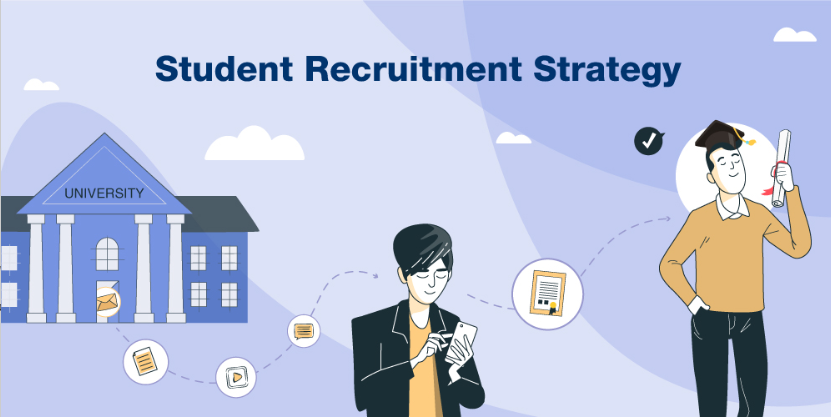A strong student recruitment strategy is rooted in the understanding that choosing a university is often a student’s first major decision. However, as student numbers decline, competition rises, and demographics change, institutions’ strategies to guide them in making this choice must change as well.
A winning recruitment strategy in 2025 must adapt to these shifts, address declining enrollments, and stand out in a crowded and fast-evolving sector.
Understanding the Modern Student Recruitment Landscape
To understand what must change in institutions’ student recruitment strategies, let’s understand the modern education landscape.
A. Changing student behavior and demographics
The traditional student profile is evolving rapidly:
- It is predicted that there will be 3.1% fewer high school graduates in 2030 than there were in 2023.
- 37% of undergraduates are now over the age of 25, reflecting a rise in non-traditional, adult learners. (Source: Traditional Vs. Non-Traditional Students in Higher Education)
- 59% of college students are women, as male enrollment continues to decline. (Source: Women increasingly outnumber men at U.S. colleges—but why?)
- Hispanic/Latino students make up roughly 18% of enrollments, while White student enrollment is declining, making diversity and inclusion key priorities. (Source: Diversity in Higher Education: Facts and Statistics)
- More students are working part-time or full-time, making flexible learning formats necessary.
These students are digital natives, highly informed, and more intentional in their choices. They evaluate schools based not only on academics but on how well the overall experience aligns with their life goals. They seek flexibility, career outcomes, personal growth, and institutions that reflect their values. Meeting these demands is increasingly challenging as colleges face rising costs, shrinking budgets, and a declining student pool.
Matching these expectations, while also adjusting to the evolving realities (like funding freeze), presents a significant challenge in developing an effective recruitment strategy. The challenges might get worse in 2025 as colleges continue to face rising costs and a shrinking student pool. What are some of those challenges, you ask?
- Peak and Decline Projections
The much-discussed “enrollment cliff” is approaching with significant implications for higher education. According to WICHE’s latest projections, key findings include:
- Peak year: 2025 with 3.8-3.9 million high school graduates
- Projected decline: 3.1% by 2030 compared to 2023 levels
- Long-term impact: 13% decrease from 2025 peak by 2041
- Regional variations: 38 states expecting decreases, while 12 states plus D.C. projecting increases
- Age and Non-Traditional Students
Although most college students are still between the ages of 18 and 24, the proportion of non-traditional students (those over 25), including working adults going back to school, is increasing.
More than one-third (37%) of undergraduates are over 25.
- Race and Ethnicity Shifts
Current enrollment statistics show significant shifts in student demographics:
- 18% of college students are Hispanic or Latino, and their enrollment is growing.
- White students now make up around half of undergraduates, although their enrollment is dropping.
- The percentage of Black students enrolled has stayed constant at about 11%.
- Approximately 6% of students are Asian, a growing percentage.
(Source: Diversity in Higher Education: Facts and Statistics | BestColleges)
- Socio-economic Background
About 30% of undergraduates in the US are first-generation college students, which means that the recruitment and retention process needs more assistance. (Source: The Importance and Challenges of First-Generation College Students – Forward Pathway)
Financial obstacles are a big worry because decisions about higher education are influenced by growing tuition prices and student loan debt.
- Transition to Online and Hybrid Education
In the US, 11.8 million students completed at least one online learning course. (Source: 70 eLearning Statistics (2025): Facts, Growth, & Success Rate)
Enrollment in fully online degrees is increasing, drawing in more international and adult learners.
B. Key factors influencing students’ choice
- Cost: Transparent tuition, financial aid, and scholarships are critical.
- Career Outcomes: Strong job placement, internships, and alumni networks matter more than ever.
- Flexibility: Students want learning options: online, in-person, or hybrid.
- Location: Proximity, safety, and lifestyle influence decisions.
- Reputation: Specialized program strength often outweighs overall ranking.
- Value Alignment: More students are looking to attend institutions that align with their personal values. This includes commitment to causes like sustainability and inclusion.
Institutions must adjust to a declining number of traditional students, draw in more non-traditional and diverse students, and provide flexible, career-focused programs in order to remain competitive. As student behavior changes, universities must reassess and adapt their recruitment strategies to remain relevant.
Key Student Recruitment Strategies
Let’s look at the student recruitment strategies you must implement for today’s changing student behavior.
A. Data-driven student recruitment strategies
Data-driven recruitment strategies have become essential for attracting and engaging the right students. By leveraging technology, universities can make the student recruitment process more efficient, personalized, and predictive. Here’s how data and technology are reshaping recruitment strategies:
1. Using Technology to Simplify the Student Recruitment Process
Institutions should use technology to automate important recruitment tasks such as nurturing leads, following up with communication, and managing applications. This minimizes manual work, accelerates response times, and ensures that no prospective student is missed.
Moreover, Customer Relationship Management (CRM) systems (such as LeadSquared) can be used to track interactions with students, categorize prospects based on their interests or readiness to apply, and manage personalized outreach effectively. With a more streamlined process, universities can concentrate their efforts on high-potential leads, thereby improving conversion rates while conserving time and resources.
2. Predictive Analytics: AI-Driven Insights to Identify Potential Students and Predict Enrollment Trends
Predictive analytics has become an essential tool in contemporary student recruitment. By utilizing AI-driven insights, universities can forecast which students are most likely to apply and enroll, based on their behaviors and interactions with the university’s recruitment channels. These insights are derived from analyzing extensive data, including website visits, social media engagement, application trends, and even external data sources like demographic trends or school performance metrics.
For instance, predictive models can pinpoint students who exhibit early signs of interest, such as frequent visits to a program’s webpage or interactions with an online advertisement. AI can also assist in forecasting enrollment trends using historical data, enabling universities to allocate resources efficiently, enhance marketing campaigns, and anticipate potential challenges in their recruitment efforts.
3. Personalization at Scale
Personalization has become essential in student recruitment, as today’s prospective students seek experiences that cater to their individual needs, interests, and goals. However, managing personalized communication with a large number of leads can be quite challenging. This is where solutions like FloStack by LeadSquared step in.
FloStack is a platform designed to assist universities in creating and delivering highly personalized student recruitment experiences on a large scale. It streamlines the enrollment process by instantly connecting with prospective students, automating lead prioritization, and simplifying meeting scheduling—all while providing personalized experiences through customized microsites. Thus, universities can preserve the human element in their recruitment process while maintaining efficiency. Students feel appreciated and understood, as they receive communications that are both relevant and timely.
B. Digital Marketing Strategies for Student Recruitment
For universities aiming to differentiate themselves and connect with potential students, adopting a well-rounded digital marketing strategy is essential. This approach should not only aim to attract students but also foster meaningful relationships through consistent messaging, engaging content, and clear communication.
Here’s a look at some key digital marketing strategies for student recruitment:
1. Establish and maintain Your Brand Identity
Before implementing digital marketing tactics, it’s important to grasp your identity as a brand and the audience you wish to attract. Your university’s brand identity should embody its values, culture, and vision while appealing to your target student demographic. To start, consider these questions: What is your institution’s core mission? What sets your university apart—its academic offerings, campus culture, or success stories?
After defining your brand, ensure consistency across all platforms. From your website to social media profiles and advertisements, every communication should reflect your university’s character and resonate with your ideal student. For example, if you’re aiming to attract a diverse, socially –conscious student body, emphasize your commitment to inclusion, sustainability, and community.
Key focus areas:
- Showcase your strengths – Highlight your academic programs, student life, and faculty engagement.
- Engage your audience – Tailor your messaging to resonate with prospective students’ aspirations, challenges, and dreams.
For example, Olivet Nazarene University has a branding that plays on its strengths. The university’s brand is built around its commitment to Christian faith, learning, and community, which resonates with prospective students who share these values. By defining your college’s brand, you can create a compelling narrative that showcases your unique strengths and attracts prospective students who are looking for a specific type of educational experience.
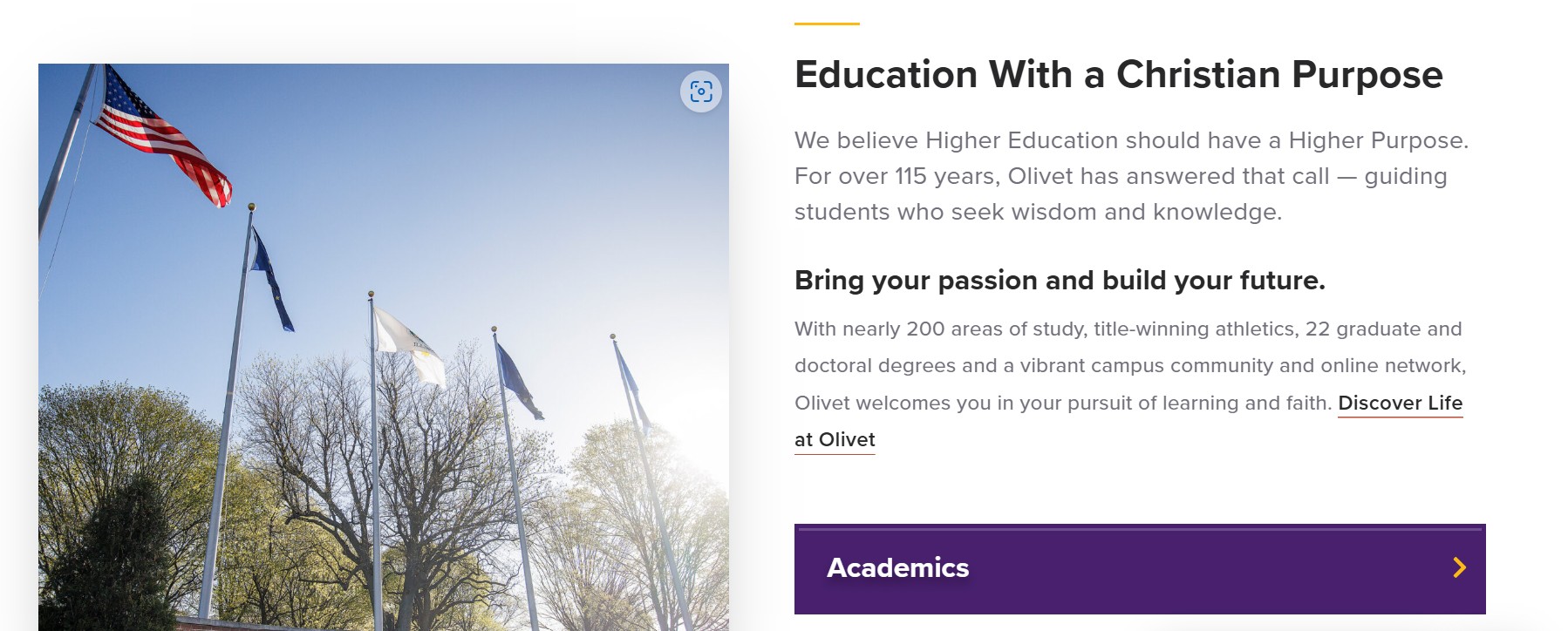
2. Search Engine Optimization (SEO)
SEO is crucial to achieve a higher ranking on search engines like Google, ensuring that your institution shows up when students look for programs, campuses, or opportunities.
To enhance your SEO, concentrate on:
- Targeted keywords: Investigate what prospective students are searching for, such as “top business programs for undergraduates” or “online master’s in computer science,” and tailor your content around those phrases.
- On-page SEO: Make sure your website is well-structured with clean URLs, optimized headings, and relevant content.
- Local SEO: If your campus draws many local students, include location-specific keywords and claim your Google My Business listing to appear in local searches.

Key focus area:
Highlight key programs – Aim to rank for specific, high-demand course offerings that may appeal to students.
3. Content Marketing: The Power of Video, TikTok, and Instagram Reels
It’s a media-driven world. Content marketing is essential for attracting the right students. While traditional text-based content like blogs and articles still hold value, video content has emerged as one of the most impactful forms of communication — particularly for Gen Z students. 86% of companies directly attribute their increased revenue to video.
Video content on platforms such as TikTok and Instagram Reels is highly effective at grabbing attention. These formats enable you to showcase student experiences, campus life, and highlight key academic programs in a way that feels engaging and authentic. Think about sharing short, relatable videos that feature:
- Virtual campus tours
- Day-in-the-life student experiences
- Behind-the-scenes glimpses of campus events
- Testimonials from current students or alums

Key focus area:
- Present your best self – Develop content that emphasizes your university’s strengths, values, and unique qualities.
- Make your students feel addressed – Tackle prospective students’ concerns (like affordability, inclusivity, accommodation, and career prospects) through your video content.
4. Social Media Engagement
Social media has become a crucial element in student recruitment strategies. It offers a direct and casual way for universities to connect with prospective students. By engaging with students on social media, you can humanize your brand and create a sense of community. Here are some tips to enhance your social media presence:
- Interactive content: Incorporate polls, Q&A sessions, and quizzes to engage students and collect valuable feedback.
- Student-generated content: Motivate current students and alums to share their experiences on social media, whether through Instagram stories or LinkedIn posts.
- Influencer partnerships: Team up with student influencers or bloggers who can help promote your university to a broader, relevant audience.

Key focus area:
Make your students feel valued – Address their questions, provide advice, and demonstrate that your institution is approachable and student-focused.
Discuss finances – Offer scholarship opportunities and other essential financial information that students should be aware of.
5. Email and Text Marketing
Even with the growing popularity of social media and various digital communication platforms, email and text marketing remain essential tools for student recruitment. These strategies enable universities to deliver personalized and targeted messages straight to potential students.
- Email marketing: Utilize segmented email lists to provide tailored content that aligns with student interests, such as particular programs, scholarship opportunities, or campus tours. Make sure your emails are visually engaging, include clear calls to action, and offer valuable information.
- Text marketing: For more immediate outreach, use SMS campaigns to remind prospective students about important application deadlines, open houses, or scholarship opportunities.
Key focus area:
- Showcase your strengths – Use email and text messages to highlight success stories, upcoming events, or exciting announcements.
- Engage your students – Personalize your communication — students are more likely to respond with their name, and when the message resonates with their specific needs and interests.
6. Pay-per-click and Retargeting Ads
Paid advertising plays a crucial role in digital marketing. Pay-per-click (PPC) ads and retargeting ads are effective strategies for attracting targeted traffic to your university’s website or landing pages.
- PPC Ads: Use platforms such as Google Ads and Facebook Ads to focus on specific keywords or student demographics. For instance, you can design ads aimed at students searching for “top engineering colleges” or those interested in your online programs.
- Retargeting ads: These ads are designed for prospective students who have previously visited your website or engaged with your content. By retargeting them with additional messages or offers, you can ensure your university remains a prominent option as they navigate their decision-making process.

Key focus area:
- Showcase your strengths – Leverage PPC and retargeting ads to highlight your university’s highly rated programs, esteemed faculty, and impressive campus facilities.
- Address financial concerns – Provide clear information about financial aid options or tuition discounts to appeal to students who are mindful of costs.
C. Student Recruitment Strategies Focusing on Student Experience
Student recruitment strategies must focus not only on attracting students but also aim to create an engaging and meaningful experience that aids them in making informed choices. By blending virtual tools with traditional recruitment methods, institutions can enhance the overall student experience, offering more flexibility and accessibility while keeping a personal touch. Here are some of the most effective strategies that schools can implement:
1. Virtual Open Days and Webinars: Crafting Engaging Virtual Experiences
How Institutions Can Create Engaging Virtual Experiences:
- Interactive Campus Tours: Virtual campus tours featuring 360-degree videos or live-streamed events allow students to explore the campus from anywhere. These tours can include live narration, Q&A sessions, and testimonials from current students, giving prospective students a glimpse into the campus culture.
- Webinar Sessions with Faculty and Alums: Organizing webinars with current professors and alums creates an interactive environment for potential students to discover specific programs, career outcomes, and personal stories from those who have experienced the journey.
- Live Chats and Real-time Engagement: Enhancing these virtual events with live chat options or interactive polls keeps students engaged, ensuring their questions and concerns are addressed promptly.
2. AI-powered Chatbots and Live Q&A: Automating Responses While Keeping Interactions Personal
AI-powered chatbots have transformed student recruitment by offering immediate responses around the clock to prospective students. These chatbots are designed to handle common inquiries about admissions, course offerings, campus life, deadlines, and other important information.
Balancing Automation and Personalization:
- Automated Yet Personal Conversations – Chatbots utilize natural language processing (NLP) to comprehend questions and deliver personalized answers. While this technology enables automation, it ensures that the interaction feels human. For instance, the bot can greet a prospective student by name and provide specific information related to their chosen course.
- Live Q&A with Admissions Teams – Chatbots can arrange live sessions with admissions officers or department heads for more in-depth questions. This way, while the bot can handle immediate inquiries, more complex or personal questions are still addressed by real people, enhancing the recruitment experience.
- Data-Driven Insights – AI tools can also monitor the types of questions asked, allowing institutions to gather valuable insights into the concerns and interests of prospective students. This information can be leveraged to enhance the overall recruitment strategy and refine outreach efforts.
3. Gamification in Recruitment: Enhancing Student Engagement through Interactive Elements
Gamification serves as a powerful strategy in student recruitment, introducing fun, competition, and interactivity into the process. By integrating gamified experiences, institutions can engage students in a lively and creative manner.
How Interactive Elements Can Enhance Engagement:
- Interactive Quizzes and Challenges – Institutions can design quizzes that assist students in discovering which programs align with their interests and skills. Presenting the quiz as a challenge or game makes it more appealing, encouraging students to participate and enjoy the experience, which can lead to improved conversion rates.
- Virtual Competitions and Leaderboards – Organizing virtual competitions focused on academics, creative projects, or even campus trivia can spark excitement and foster a sense of community among prospective students. Those who take part in these games and activities may develop a stronger connection to the institution and its culture.
- Points and Rewards Systems – Providing incentives like exclusive content, early access to application materials, or discounts on event tickets for engaging in gamified activities can motivate prospective students to dive deeper. These systems instill a sense of progression, encouraging students to explore various facets of the university, from academic programs to extracurricular opportunities.
D. Leveraging Partnerships for Student Recruitment
The higher education environment is competitive, and universities and colleges are increasingly relying on partnerships to enhance student recruitment. By collaborating with external organizations such as high schools, community groups, businesses, and international agencies, institutions can broaden their reach and create a steady flow of potential students. These partnerships not only strengthen recruitment initiatives but also offer students greater chances to connect with the real world, gain career insights, and explore international opportunities.
Here are some key partnership strategies that institutions can utilize to refine their recruitment processes:
1. High School and Community Outreach Programs: Building Relationships
Establishing strong connections with high schools and community colleges is an effective way to ensure a consistent influx of prospective students. These “feeder schools” are essential in shaping the applicant pool for universities and colleges. By cultivating these relationships, institutions can engage with students early, increasing awareness of available programs and opportunities.
Strategies for building effective relationships:
- Early Engagement through College and Career Fairs – Institutions can take part in or host college fairs and recruitment events at local high schools and community colleges. This approach provides direct access to a large number of potential applicants and facilitates personalized interactions with counselors, students, and parents.
- On-Campus Events and Visits – Organizing visits or campus tours specifically for high school students is an excellent way to introduce them to campus life and academic offerings. Working with high school counselors for these visits can help align academic expectations and create a smoother transition for students.
- Mentorship and Tutoring Programs – Universities can collaborate with high schools to establish mentorship opportunities, where current university students guide high schoolers, offering academic support and advice. This builds a stronger connection to the institution and its culture.
2. Corporate and Industry collaborations: Connecting with employers to offer career-driven education
Collaborations with corporate and industry partners can significantly enhance an institution’s ability to deliver education that is relevant to students’ future careers, making them more appealing to employers after graduation. These partnerships also allow institutions to showcase the practical relevance of their programs, which is becoming increasingly important for students. Here are some effective strategies for maximizing these collaborations:
- Internships and Co-op Programs – Establishing partnerships with businesses and industries to create internship or co-op opportunities is a vital way to connect academic programs with the job market. By providing students with hands-on experience in real-world environments, institutions can set themselves apart from competitors and help students build essential professional networks before they graduate.
- Curriculum Development – Collaborating with industry partners to design or update curricula ensures that educational programs are in line with current industry demands and trends. Institutions that work with employers to create or enhance specialized programs, such as those in healthcare, technology, or business, can offer a more focused and practical education that addresses the need for skilled professionals in critical sectors.
- Career Services Partnerships – Strengthening ties with local and global employers through career fairs, networking events, and job placement initiatives facilitates students’ transition from education to employment. These partnerships can also include exclusive recruitment events, where companies actively seek out students from your institution, further enhancing job opportunities for graduates.
- Customized Corporate Training Programs – Beyond recruitment, institutions can provide tailored corporate training programs that meet the specific needs of employers. These programs may cater to professionals looking to enhance their skills or organizations aiming to cultivate specialized talent. By offering such training, institutions can play a crucial role in workforce development.
3. International Student Recruitment Strategies: Working with Agencies, Global Marketing Campaigns, and Visa Assistance
International student recruitment is becoming increasingly important for institutions aiming to diversify their student population and enhance their global presence. The competition in the international student market is fierce, making it essential to adopt effective recruitment strategies to attract top talent from overseas.
Here are some key strategies:
- Partnerships with Education Agencies – Education recruitment agencies are vital in linking institutions with international students. These agencies possess local knowledge and networks in their respective countries, enabling institutions to reach a wider audience. By collaborating with reputable agencies, institutions can simplify the recruitment process and enhance their visibility in important international markets.
- Global Marketing Campaigns – Crafting targeted global marketing campaigns is crucial for raising awareness and drawing in international students. This may include digital advertising, social media outreach, and content marketing tailored to specific regions or countries. Highlighting testimonials from international alums, showcasing the institution’s global standing, and emphasizing the support available for international students (like language assistance, visa guidance, and cultural integration programs) can significantly boost appeal.
- Visa and Immigration Support – Providing strong support for international students regarding visa application processes and immigration requirements is essential. By offering clear and accessible information on visa policies, deadlines, and necessary documentation, institutions can alleviate the stress of applying from abroad and foster trust with prospective students. Additionally, offering specialized services such as visa workshops or access to dedicated international student advisors can help an institution stand out in the competitive international recruitment landscape.
- International Recruitment Fairs – Participating in international recruitment fairs is another effective strategy. These events give colleges the chance to introduce potential students from different nations to their academic offerings, campus culture, and distinctive features. Institutions can establish a personal relationship with students and their families that may have a greater impact than online connections by interacting directly with them and offering firsthand information about scholarships, admissions standards, and job prospects. Universities can also better understand the requirements and goals of international students by visiting these fairs, which enables them to modify their marketing plans and student assistance offerings to better cater to a global community.
E. Student Referral and Ambassador Programs
Student referral and ambassador programs are gaining recognition as effective tools in the recruitment landscape. By utilizing the networks of current students and alums, institutions can foster a more genuine and personal connection with prospective students. These initiatives capitalize on the trust and influence of individuals who have already experienced what the institution has to offer, helping to establish credibility and draw in students who might not have otherwise considered the institution. Here’s how peer-to-peer recommendations, alum networks, and incentivized referral programs can collaborate to boost student recruitment:
1. Peer-to-peer Recommendations: How Current Students Can Influence Prospects
Current students are often the most relatable and trusted source of information for prospective students. Peer-to-peer recommendations draw on the experiences of students who have firsthand knowledge of campus life, academics, and the overall student experience. These recommendations tend to be viewed as more genuine and credible compared to traditional marketing materials or outreach from faculty members.
How Peer-to-Peer Recommendations Work:
- Student Ambassadors – Many universities establish formal ambassador programs where current students represent the institution. These ambassadors participate in recruitment events, lead campus tours, engage in webinars, and connect with prospective students through social media. By sharing their experiences and insights into academic programs and campus life, student ambassadors help to humanize the institution and foster an authentic connection with prospective students.
For instance, the Georgetown University had one of their students make a video on choosing the right college, and it also helped gain some positive publicity for the University.
- Peer Mentoring – Peer mentoring programs match prospective or incoming students with current students in similar academic fields or student organizations. This mentorship offers prospective students a more personal, hands-on perspective of life at the institution, addressing questions and concerns from someone who has navigated the same journey.
- Social Media Engagement – Today’s students are digitally connected, and many prospective students turn to social media to learn more about their potential college experience. Current students can serve as “influencers” by sharing their experiences on platforms like Instagram, TikTok, or YouTube. By highlighting campus events, student organizations, and daily life, students provide a real-time, authentic glimpse into their experiences. Encouraging these students to actively share content can create a more relatable, peer-driven narrative that resonates with prospective students.
2. Alum Networks: The Power of Alum Success Stories in Recruitment
Alum networks serve as a vital resource for recruitment by showcasing the achievements of former students who have built impressive careers or made significant contributions to their communities. These success stories illustrate the real benefits of the education and experiences provided, demonstrating to prospective students how their investment in the institution can lead to future accomplishments.
How Alum Networks Enhance Recruitment Efforts:
- Highlighting Success Stories – Alums can become influential brand ambassadors by sharing their career milestones and personal narratives. These stories enable prospective students to recognize the long-term value of their education. Institutions can develop campaigns that feature alums from various fields, showcasing the wide range of career paths available to their graduates.
- Alums as Mentors and Speakers – Many universities implement formal mentoring programs where alum volunteers support current students or provide guidance to prospective students. Alums can also participate as speakers at recruitment events, webinars, and panels, sharing their journey from student to professional and illustrating how the university played a role in their development.
- Networking Events and Reunions – Organizing alum networking events or reunions that prospective students can attend allows them to connect with graduates and learn about their experiences. These gatherings provide authentic testimonials about the institution’s influence and can foster valuable connections that may lead to internships, job opportunities, or professional insights.
- Alum-driven Digital Campaigns – Probably the first thing people take note of about a university is the opinion of former students on it. Showcasing alum success stories on social media, institutional websites, and email newsletters can attract prospective students who aspire to follow similar career trajectories. These digital initiatives foster a strong sense of community, helping prospective students envision themselves as future alums.
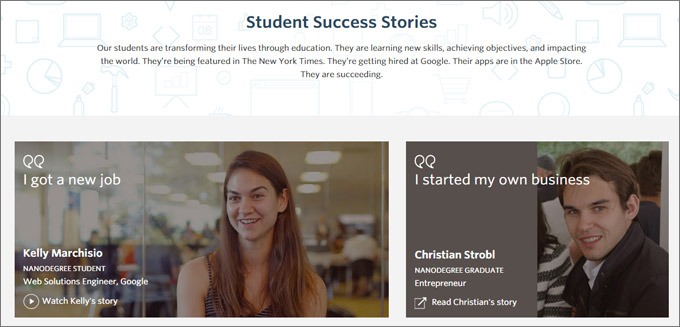
3. Incentivized Referral Programs: Encouraging Students to Refer Friends
Incentivized referral programs aim to motivate current students to recommend friends, classmates, or acquaintances who might be interested in applying to the institution. By providing rewards or recognition, these programs leverage the social networks of existing students and inspire them to share the advantages of their university experience.
How Incentivized Referral Programs Work:
- Referral Rewards – Institutions can provide tangible incentives, such as gift cards, event tickets, or exclusive merchandise, to students who successfully refer others. Rewards can be tiered, offering higher-value incentives for those who refer multiple prospective students. This creates a win-win scenario where both the referring student and the referred student gain benefits.
- Contests and Competitions – To boost engagement, universities can transform the referral program into a friendly competition. For instance, students who refer the most successful applicants might win a grand prize, such as a scholarship, a free semester of textbooks, or even a trip to a major academic conference. Gamifying the referral process can significantly enhance participation and excitement.
- Recognition and Prestige – Some institutions prioritize recognition over material rewards. For example, students who refer the most applicants could be publicly celebrated through newsletters, social media shout-outs, or special “top referrer” awards at university events. This acknowledgment can be a strong motivator for students who appreciate peer recognition and status.
- Referral Tracking and Automation – Modern referral programs utilize automated tracking systems that simplify the process for students to refer prospects. Simple referral links or codes can be shared across various platforms, allowing students to participate without complicated paperwork. This automation streamlines the referral process and encourages higher participation rates.
F. Measuring and Optimizing Recruitment Efforts
Successful recruitment strategies are essential for educational institutions, businesses, and organizations that want to draw in the right candidates, students, or customers. To make these efforts as effective and efficient as possible, it’s important to measure and optimize recruitment activities through data-driven methods. This involves monitoring key performance indicators (KPIs), using A/B testing techniques, and focusing on continuous improvement. Let’s discuss how each of these components can significantly enhance recruitment efforts.
1. Key Performance Indicators (KPIs)
KPIs are essential for evaluating the success of recruitment initiatives. By identifying and monitoring relevant metrics, organizations can gain insights into the performance of their campaigns, identify areas needing improvement, and make informed decisions regarding resource allocation. Some of the most important KPIs in recruitment include:
- Enrollment Rates – This metric directly reflects the effectiveness of a recruitment strategy. Enrollment rates track the number of individuals who complete the application or registration process and ultimately enroll. It’s crucial to compare enrollment rates across various recruitment channels (such as online and in-person) to identify which methods produce the best outcomes.
- Lead Conversion – Lead conversion indicates the percentage of prospects (like applicants) who become actual enrollees or students. By analyzing this KPI, institutions can evaluate the success of their nurturing and follow-up efforts and discover ways to enhance their communication strategies.
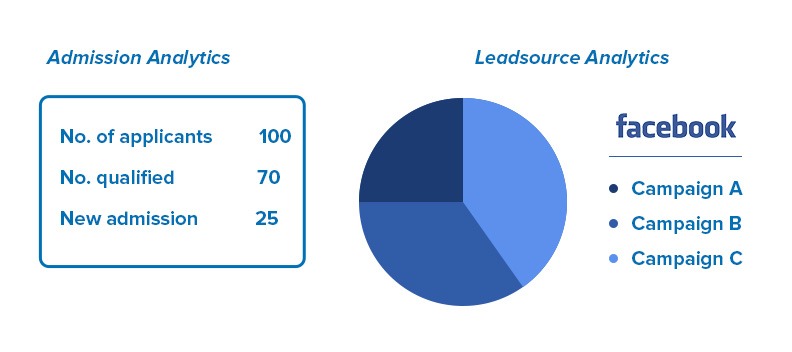
- Engagement Metrics – These metrics assess how actively prospects engage with recruitment content. Engagement can be measured through indicators such as email open rates, click-through rates (CTR), social media interactions, website visits, or attendance at recruitment events. High levels of engagement often suggest greater interest and, consequently, higher conversion rates.
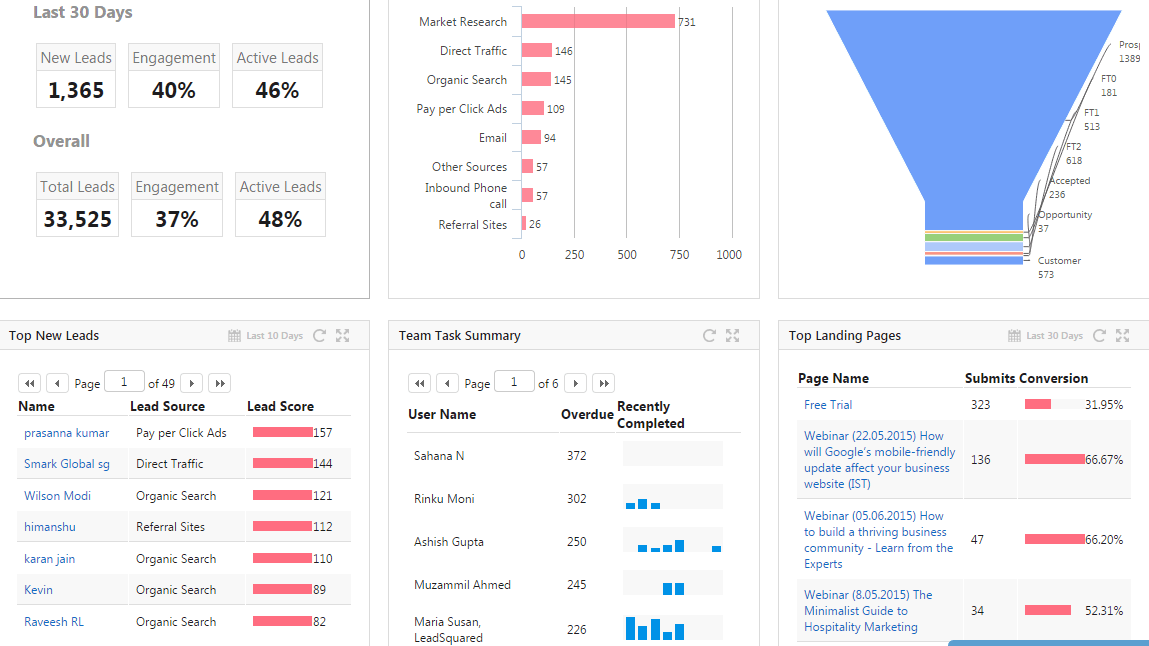
2. A/B Testing Strategies
A/B testing, also known as split testing, is an effective method for comparing two or more variations of a recruitment campaign to determine which one performs better. This technique helps pinpoint the messaging, visuals, and formats that resonate most with potential candidates or students.
Here are some common elements that institutions might consider A/B testing:
- Messaging – Different wording or approaches can lead to varying responses. By testing different headlines, calls to action (CTAs), and body copy, institutions can discover which language drives more engagement or conversions. For instance, they could compare “Apply Now” with “Join Us Today” to see which phrase results in higher click-through rates.
- Design and Visuals – The design and overall look of recruitment materials—whether they are digital ads, landing pages, or brochures — significantly impact user experience. By experimenting with different layouts, color schemes, or images, recruiters can enhance their visual elements to capture the right attention.
- Campaign Channels – Not all communication channels yield the same results. A/B testing across email campaigns, social media ads, and website landing pages can help identify the most effective platform for reaching and engaging prospects. Institutions might explore variations in ad copy, imagery, or even posting times to optimize campaign performance.
- Lead Magnets – Providing valuable resources like e-books, webinars, or consultations can encourage prospects to take the next step in the enrollment process. A/B testing can help determine which types of lead magnets attract the most qualified leads.
3. Continuous Improvement
Recruitment is an ongoing endeavor; it requires constant adjustments and improvements. Institutions that adopt a continuous improvement mindset can keep up with trends, tackle challenges, and ultimately draw in more qualified candidates.
Here are some ways institutions can sustain this cycle of continuous improvement:
- Regular Data Review – By consistently tracking and analyzing recruitment data, institutions can remain flexible and responsive. Regularly reviewing key performance indicators (KPIs) helps identify patterns or issues early, enabling timely adjustments. For instance, if lead conversion rates start to drop, it may be necessary to modify follow-up strategies or reassess messaging.
- Feedback Loops – Collecting feedback from candidates, students, or recruits is crucial for refining recruitment strategies. Surveys, interviews, or informal feedback can provide qualitative insights that complement quantitative KPIs. Institutions can inquire about recruits’ decision-making processes, what inspired them to apply, and which elements of the recruitment process they found most beneficial.
- Adaptation to Market Changes – The recruitment landscape is always changing, influenced by factors such as competition, economic conditions, or shifts in candidate preferences. Institutions must stay updated on these changes and be prepared to adjust their recruitment strategies accordingly. Continuous learning and adaptation are essential for maintaining effectiveness.
- Technology Integration – Integrating technology such as data analytics tools, customer relationship management (CRM) systems, and marketing automation platforms can enhance the recruitment process. These tools enable institutions to gather data, monitor key performance indicators (KPIs), and tailor their outreach efforts, leading to improved decision-making and a more efficient recruitment strategy.
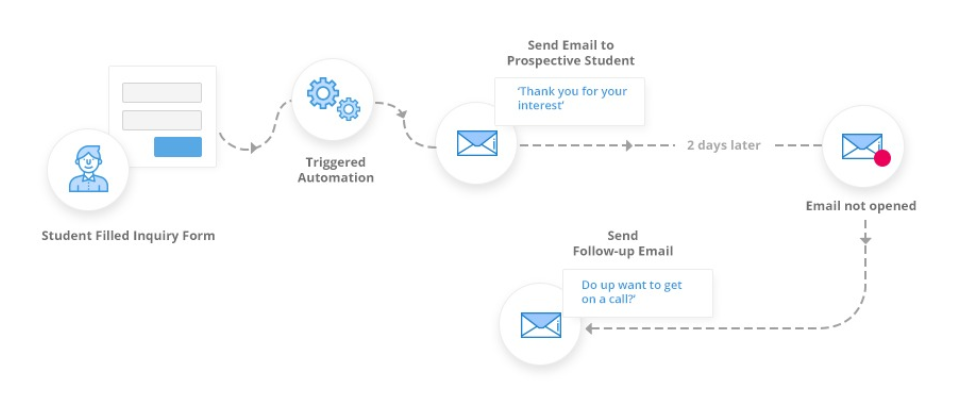
As part of your strategies, you may be looking to eliminate student drop-offs and boost student engagement. Or looking to increase your counselor’s productivity. Or maybe aiming to gain better control over management and improve forecasting. We have put an e-book that can help you learn how Asher College skyrocketed their enrollment rates! The e-book will show you how to optimize workflows for better results. It will guide you through using Smart Views and Lead Scoring to streamline their efforts. Plus, it will teach you how to leverage reporting tools effectively.
Take your processes to the next level.
Wrapping Up
The educational environment is rapidly changing, and it’s crucial for institutions to adopt effective student recruitment strategies to remain competitive and attract a diverse, high-quality student body. By utilizing a mix of data-driven insights, innovative outreach initiatives, and strategic partnerships, institutions can set themselves up for success.
However, recruitment isn’t a one-size-fits-all process. For true success, institutions need to be adaptable, continuously refining their strategies based on data and emerging trends. A tool like LeadSquared can greatly improve these strategies by simplifying lead capture, monitoring interactions, and automating follow-ups, making sure that no potential student is overlooked.
With its strong CRM features, LeadSquared enables institutions to effectively manage and nurture their leads through tailored communication and data insights, boosting conversion rates and overall recruitment success. Leverage it to optimize your lead management and communication efforts, ensuring a seamless experience for prospective students! Book a demo today.
Frequently Asked Questions (FAQs)
A combination of digital platforms, including social media, email campaigns, and educational fairs, are the most successful ways to recruit students. Every channel has a distinct function; email marketing enables individualized interaction, and social media aids in increasing brand recognition. Reaching potential students at different points in their decision-making process is ensured by combining these channels.
The secret lies in personalization. Segment your leads according to program preferences, geography, interests, and professional objectives should be your first step. After that, adjust your messaging appropriately. Relevant content, personalized emails, and targeted advertisements increase engagement rates and strengthen students’ sense of belonging to your school. Tools like LeadSquared can help you simplify and streamline these processes.
Monitor key performance indicators (KPIs) including conversion rates, lead-to-student ratios, and cost per lead to gauge the effectiveness of your student recruitment tactics. Additionally, you can use LeadSquared to make sure you’re using your money wisely and optimize your future tactics by evaluating the efficacy of each recruitment channel and figuring out which touchpoints result in higher conversions.
Helpful resources:
- Edutech: Emerging technologies in the Education Sector
- How to Create Highly Useful College Student Personas
- College Branding: 5 Steps to Making Your Brand Standout





